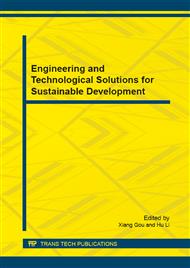[1]
Daud N. K., Hameed B. H. Decolorization of Acid Red 1 by Fenton-like process using rice husk ash-based catalyst[J]. Journal of Hazardous Materials, 2010, 176(1): 938-944.
DOI: 10.1016/j.jhazmat.2009.11.130
Google Scholar
[2]
Muruganandham M., Swaminathan M. Decolourisation of reactive orange 4 by Fenton and photo-Fenton oxidation technology[J]. Dyes and Pigments, 2004, 63(3): 315-321.
DOI: 10.1016/j.dyepig.2004.03.004
Google Scholar
[3]
Sirtori C., Zapata A., Oller I., et al. Decontamination industrial pharmaceutical wastewater by combining solar photo-Fenton and biological treatment[J]. Water Research, 2009, 43(3): 661-668.
DOI: 10.1016/j.watres.2008.11.013
Google Scholar
[4]
Catalkaya E. C., Kargi F. Effects of operating parameters on advanced oxidation of diuron by the Fenton's reagent: A statistical design approach[J]. Chemosphere, 2007, 69(3): 485-492.
DOI: 10.1016/j.chemosphere.2007.04.033
Google Scholar
[5]
Santos M. S. F., Alves A., Madeira L. M. Paraquat removal from water by oxidation with Fenton's reagent[J]. Chemical Engineering Journal, 2011, 175(11): 279-290.
DOI: 10.1016/j.cej.2011.09.106
Google Scholar
[6]
Boussahel R., Harik D., Mammar M., et al. Degradation of obsolete DDT by Fenton oxidation with zero-valent iron[J]. Desalination, 2007, 206(1): 369-372.
DOI: 10.1016/j.desal.2006.04.059
Google Scholar
[7]
Martins R. C., Silva N. A., Quinta-Ferreira R. M. Ceria based solid catalysts for Fenton's depuration of phenolic wastewaters, biodegradability enhancement and toxicity removal[J]. Applied Catalysis B: Environmental, 2010, 99(1): 135-144.
DOI: 10.1016/j.apcatb.2010.06.010
Google Scholar
[8]
Liou R. M., Chen S. H., Hung M. y., et al. Fe(III) supported on resin as effective catalyst for the heterogeneous oxidation of phenol in aqueous solution[J]. Chemosphere, 2005, 59(1): 117-125.
DOI: 10.1016/j.chemosphere.2004.09.080
Google Scholar
[9]
Hu X. D. Pharmaceutical wastewater treatment technologies and case studies[J]. Beijing: Chemical publisher, 2008. (In Chinese).
Google Scholar
[10]
Jamil T. S., Ghaly M. Y., EI-Seesy I. E., et al. A comparative study among different photochemical oxidation process to enhance the biodegradability of paper mill wastewater[J]. Jounral of Hazardous Materials, 2011, 185(1): 353-358.
DOI: 10.1016/j.jhazmat.2010.09.041
Google Scholar
[11]
Moradas G., Auresenia J., Gallardo S., et al. Biodegradability and toxicity assessment of trans-chlordane photochemical treatment[J]. Chemoshere, 2008, 73(9): 1512-1517.
DOI: 10.1016/j.chemosphere.2008.07.035
Google Scholar
[12]
Körbahti B. K., Aktas N., Tanyolac A. Optimization of electrochemical treatment of industrial paint wastewater with response surface methodology[J]. Journal of Hazardous Materials, 2007, 148(1): 83-90.
DOI: 10.1016/j.jhazmat.2007.02.005
Google Scholar
[13]
Lei H.Y., Li H. L., Li Z., et al. Electrol-Fenton degradation of cationic red X-GRL using an activated carbon fiber cathode[J]. Process Safety and Environmental Protection, 2010, 88(6): 431-438.
DOI: 10.1016/j.psep.2010.06.005
Google Scholar
[14]
Weng C. H., Lin Y. T., Chang C. K., et al. Decolourization of direct blue 15 by Fenton/ultrasonic process using a zero-valent iron aggregate catalyst[J]. Ultrasonics Sonochemistry, 2013, 20(3): 970-977.
DOI: 10.1016/j.ultsonch.2012.09.014
Google Scholar
[15]
Liu S.T., Huang J., Ye Y., et al. Microwave enhanced Fenton process for the removal of methylene blue from aqueous solution[J]. Chemical Engineering Journal, 2013, 216(1): 586-590.
DOI: 10.1016/j.cej.2012.11.003
Google Scholar
[16]
Atta A. Y., Jibril B. Y., Al-Waheibi T. K., et al. Microwave-enhanced catalytic degradation of 2-nitrophenol on alumina-suppored copper oxides[J]. Catalysis Communications, 2012, 26(12): 112-116.
DOI: 10.1016/j.catcom.2012.04.033
Google Scholar
[17]
Wu D. L., Yang Z. Z., Wang W., et al. Ozonation as an advanced oxidant in treatment of bamboo industry wastewater[J]. Chemosphere, 2012, 88(9): 1108-1113.
DOI: 10.1016/j.chemosphere.2012.05.011
Google Scholar
[18]
Zhang L. S., Yang G. P., Wang W. Ozone oxidation in water treatment[J]. Water purification technology, 2003, 22(1): 9-11, 31. (In Chinese).
Google Scholar


